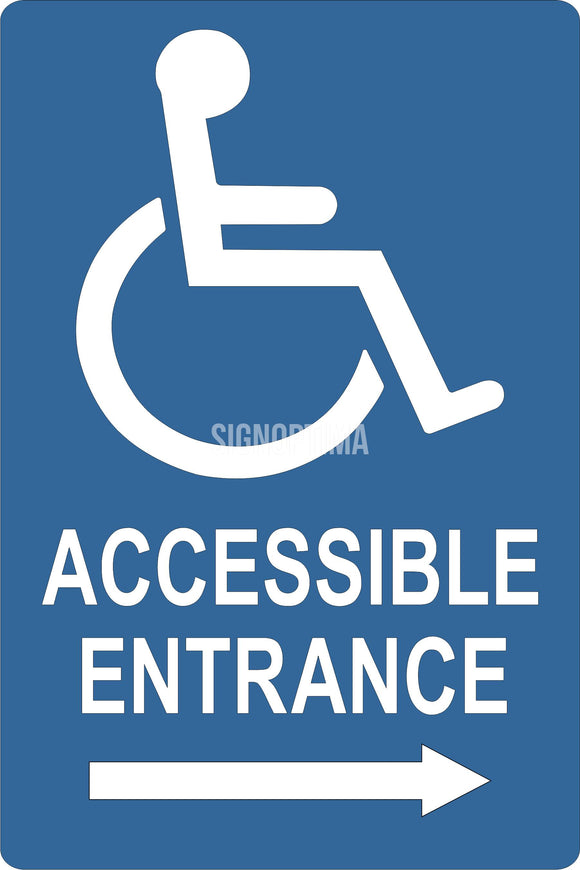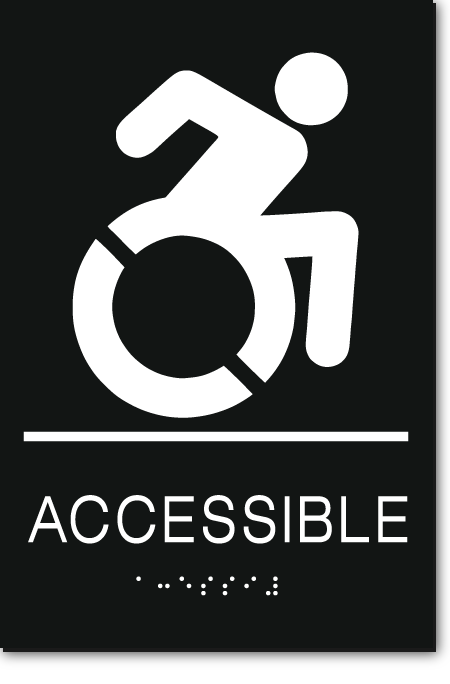Checking Out the Trick Functions of ADA Indicators for Boosted Accessibility
In the realm of availability, ADA indicators serve as quiet yet powerful allies, making certain that spaces are comprehensive and accessible for people with handicaps. By incorporating Braille and responsive aspects, these indications damage barriers for the aesthetically damaged, while high-contrast color pattern and readable font styles accommodate diverse aesthetic demands. Moreover, their tactical placement is not approximate yet rather a computed initiative to promote seamless navigation. Yet, past these attributes lies a deeper narrative about the development of inclusivity and the recurring commitment to creating equitable spaces. What extra could these indications signify in our pursuit of global ease of access?
Value of ADA Conformity
Guaranteeing compliance with the Americans with Disabilities Act (ADA) is crucial for fostering inclusivity and equal access in public rooms and work environments. The ADA, established in 1990, mandates that all public centers, companies, and transport services accommodate people with handicaps, guaranteeing they delight in the exact same civil liberties and chances as others. Conformity with ADA criteria not only satisfies lawful responsibilities however likewise enhances a company's reputation by demonstrating its commitment to variety and inclusivity.
Among the vital elements of ADA compliance is the application of obtainable signage. ADA indications are created to ensure that individuals with specials needs can conveniently navigate through areas and structures. These indicators have to stick to particular guidelines concerning dimension, font, shade comparison, and positioning to assure exposure and readability for all. Effectively implemented ADA signage assists eliminate obstacles that individuals with impairments commonly encounter, thus advertising their independence and confidence (ADA Signs).
Moreover, sticking to ADA regulations can minimize the danger of legal effects and possible penalties. Organizations that fail to follow ADA guidelines may face suits or penalties, which can be both harmful and monetarily burdensome to their public picture. Hence, ADA conformity is important to fostering an equitable atmosphere for everybody.
Braille and Tactile Components
The incorporation of Braille and tactile aspects right into ADA signage personifies the concepts of ease of access and inclusivity. It is typically positioned underneath the matching message on signs to ensure that individuals can access the info without visual help.
Responsive aspects extend past Braille and consist of raised personalities and signs. These components are developed to be discernible by touch, enabling people to identify space numbers, restrooms, exits, and other vital locations. The ADA sets particular guidelines pertaining to the dimension, spacing, and positioning of these tactile elements to enhance readability and make sure consistency throughout various environments.

High-Contrast Color Schemes
High-contrast shade plans play an essential duty in improving the visibility and readability of ADA signs for individuals with aesthetic disabilities. These plans are essential as they make the most of the distinction in light reflectance between text and background, making certain that indications are conveniently discernible, also from a distance. The Americans with Disabilities Act (ADA) mandates using specific shade contrasts to accommodate those with limited vision, making it a critical element of conformity.
The effectiveness of high-contrast shades lies in their capability to stick out in numerous illumination problems, including dimly lit environments and areas with glow. Normally, dark text on a light background or light text on a dark history is used to attain optimal contrast. For example, black message on a white or yellow background gives a raw aesthetic difference that helps in fast acknowledgment and comprehension.

Legible Fonts and Text Size
When thinking about the design of ADA signage, the choice of readable fonts and ideal message size can not be overstated. The Americans with Disabilities Act (ADA) mandates that fonts have to be not italic and sans-serif, oblique, manuscript, very attractive, or of unusual kind.
According to ADA standards, the minimum text height need to be 5/8 inch, and it ought to increase proportionally with viewing range. Uniformity in text dimension adds to a natural visual experience, helping individuals in browsing environments successfully.
Furthermore, spacing in between letters and lines is important to legibility. Ample spacing avoids characters from showing up crowded, enhancing readability. By sticking to these criteria, designers can significantly enhance availability, ensuring that signage offers its designated objective for all individuals, despite their aesthetic capacities.
Efficient Positioning Strategies
Strategic positioning of ADA signs is vital for making the most of access and guaranteeing conformity with lawful standards. Correctly positioned indications lead individuals with impairments successfully, promoting navigation in public rooms. Trick considerations include distance, height, and exposure. ADA guidelines stipulate that signs ought to be installed at a height between 48 to 60 inches from the ground to ensure they are within the line of sight for both standing and seated individuals. This standard elevation range is critical for inclusivity, allowing wheelchair users and individuals of varying heights to access information easily.
In addition, indications should be positioned adjacent to the lock side of doors to enable simple identification prior to entrance. Consistency in indication placement throughout a facility improves predictability, decreasing complication and improving total customer experience.

Verdict
ADA signs play an important function in promoting access by integrating features that resolve the demands of people with handicaps. These components jointly cultivate a comprehensive setting, underscoring the value of ADA compliance in making sure equal gain access to for all.
In the realm of ease of access, ADA indicators offer as quiet yet powerful allies, guaranteeing that spaces are inclusive and navigable visit for people with handicaps. The ADA, passed in 1990, mandates that all public facilities, employers, and transport services suit people with specials needs, ensuring they enjoy the very same civil liberties and opportunities as others. ADA Signs. ADA signs are designed to make certain that individuals with disabilities can easily browse with spaces and structures. ADA guidelines state that signs need Discover More to be installed at an elevation between 48 to 60 inches from the ground to ensure they are within the line of sight for both standing and seated people.ADA indications play a vital duty in promoting accessibility by incorporating functions that resolve the requirements of people with impairments